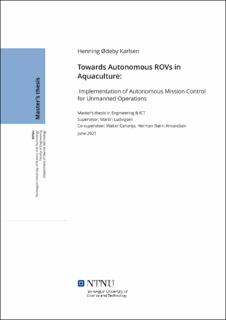| dc.contributor.advisor | Ludvigsen, Martin | |
| dc.contributor.advisor | Caharija, Walter | |
| dc.contributor.advisor | Amundsen, Herman Biørn | |
| dc.contributor.author | Karlsen, Henning Ødeby | |
| dc.date.accessioned | 2022-02-01T18:19:55Z | |
| dc.date.available | 2022-02-01T18:19:55Z | |
| dc.date.issued | 2021 | |
| dc.identifier | no.ntnu:inspera:78668897:33281090 | |
| dc.identifier.uri | https://hdl.handle.net/11250/2976418 | |
| dc.description.abstract | I denne oppgaven utformes og implementeres et autonomt system for oppdragskontroll av en autonom ROV, slik at den er i stand til å utføre autonome undervanns- inspeksjons-, vedlikeholds- og reparasjonsoppdrag innenfor akvakultur.
Autonome ROV'er med mulighet for å gjennomføre autonome inspeksjons-, vedlikeholds- og reparasjons-oppdrag kan bidra til å redusere risikoene knyttet til undervannsoperasjoner i havbruk, og muliggjøre forflytningen til mer eksponerte farvann.
For å designe systemet for autonom oppdragskontroll ble den klassiske guiding-, navigasjons- og kontrollsystem arkitekturen kombinert med ideen om en hybrid oppdragskontroll-arkitektur.
En lagdelt tilnærming for implementering av de forskjellige komponentene i hybrid oppdragskontroll-arkitekturen i et eksisterende manuelt kontrollsystem blir presentert.
En endelig tilstandsmaskin og et atferdstre blir presentert for å gjøre det enklere å lage og visualisere logikkflyten igjennom det autonome systemet for oppdragskontroll.
De forskjellige undervanns- inspeksjons-, vedlikeholds- og reparasjons-oppdragene i havbruk, og hva som vil kreves for å implementere de i et system for autonom oppdragskontroll blir etablert.
De forskjellige risikoene knyttet til bruken av autonome ROV'er i havbruk blir også etablert.
Et system for autonom oppdragskontroll blir presentert for SINTEF Oceans Argus Mini ROV, og elementer av dette blir implementert i et system for oppdragskontroll, slik at det er i stand til å utføre autonom notinspeksjon.
En tidligere implementert kontroller for autonom traversering av nota ved hjelp av en Doppler velocity log (DVL) blir benyttet som basis for en autonom notinspeksjonsmodus.
Systemet klarer å gjennomføre autonom notinspeksjon i simuleringer, men krever forbedret filtrering og en bedre algoritme for samtidig lokalisering og kartlegging (SLAM) før det vil være gunstig å bruke i fullskala akvakultur.
De to implementerte elementene er en reaktiv atferd for å håndtere tap av DVL målinger og en overveiende atferd for å ha kontroll på fremgangen i inspeksjonen og generere et mønster for autonom notinspeksjon.
Atferden for å håndtere tap av DVL målinger fungerer som tiltenkt både i simuleringer og i fullskala tester utført i et ekte oppdrettsanlegg.
Atferden for å ha kontroll på fremgangen i inspeksjonen og generere et mønster for autonom notinspeksjon fungerer som tiltenkt i simuleringer, men yter ikke godt nok i fullskala tester.
Årsaken til den noe svake ytelsen var mye støy grunnet bølger og strøm, et filter som ikke fungerte og en svak SLAM algoritme. | |
| dc.description.abstract | This thesis designs and implements an autonomous mission control system for an autonomous remotly operated vehicle (ROV) such that it is capable of performing autonomous underwater inspection, maintenance and repair (IMR) operations within aquaculture.
Autonomous ROVs capable of conducting autonomous IMR operations could reduce the different risks associated with subsea operations within aquaculture as well as enable the move towards exposed locations.
For designing the autonomous mission control system, the classical Guidance, Navigation, and Control-control architecture is combined with the idea of a hybrid mission control architecture.
A layered approach for implementing the different components in the hybrid mission control architecture in an existing manual system is proposed.
For assisting with creating and visualizing the logic flow through an autonomous mission control system, a finite state machine (FSM) and a behavior tree (BT) is proposed for an autonomous mission control system.
The different underwater IMR operations in aquaculture and what would be required for their implementation in an autonomous mission control system is established.
The different risks connected to the use of autonomous ROVs are also established.
An autonomous mission control system is then proposed for SINTEF Ocean's Argus Mini ROV, and elements of the autonomous mission control system are implemented.
A previously created controller for autonomously traversing the net by utilizing a Doppler velocity log (DVL) is used as the basis for an autonomous net inspection mode.
A smaller FSM was utilized for visualizing the logic flow within the net inspection mode.
This system is capable of performing an autonomous net inspection in simulations but requires improved filtering and better simultaneous localization and mapping (SLAM) before it is viable in a real-world aquaculture application.
The implemented elements are a reactive behavior for handling the loss of DVL measurements and a deliberative behavior for tracking the inspection progress and creating a pattern for net inspection.
The reactive behavior for handling the loss of DVL measurements performs as intended both in simulation and field tests conducted in a full-scale, real-world fish farm.
The deliberative behavior for tracking the inspection progress and creating an inspection pattern performed as intended in simulation; however, although showing promise, the performance was unsatisfactory in the real-world tests.
The unsatisfactory performance was due to a large amount of wave and current-induced noise, a flawed filter, and a poor SLAM algorithm. | |
| dc.language | eng | |
| dc.publisher | NTNU | |
| dc.title | Towards Autonomous ROVs in Aquaculture:
Implementation of Autonomous Mission Control for Unmanned Operations | |
| dc.type | Master thesis | |
